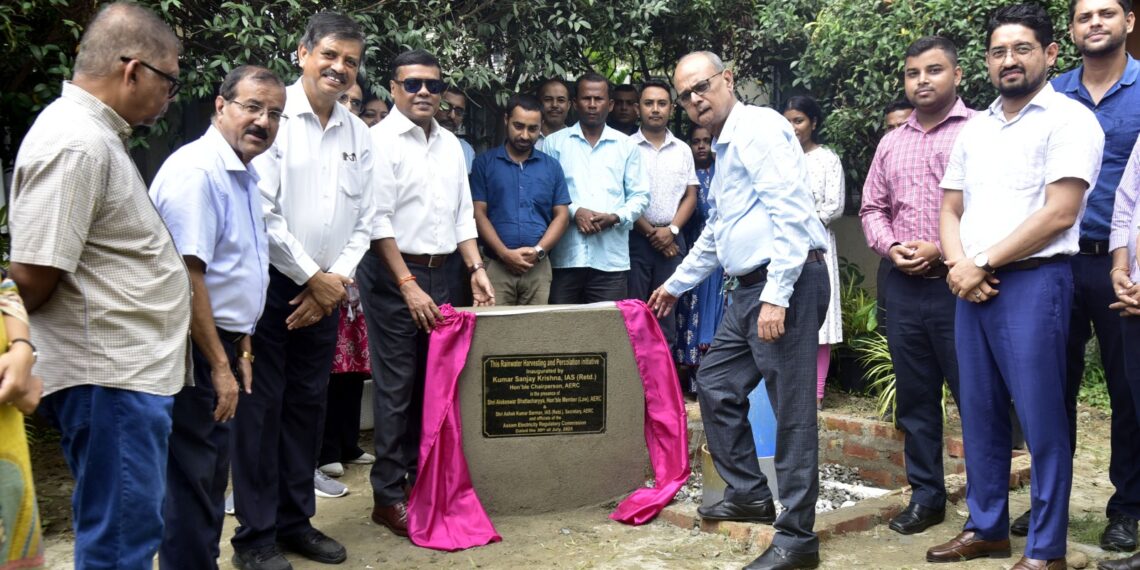Importance of rainwater harvesting: Rainwater harvesting is an essential water management practice that involves collecting and storing rainwater using various methods and systems.
The primary goal of rainwater harvesting is to reduce water scarcity, manage stormwater runoff, and ensure sustainable water resources for diverse needs.
About Rainwater Harvesting: Rainwater harvesting is a process that involves collecting and storing rainwater (with the help of an artificially designed system) that runs off natural or man-made catchment areas, such as rooftops, compounds, rock surfaces, hill slopes, or artificially repaired impervious/semi-pervious land surfaces.
Rainwater harvesting involves capturing rainwater from surfaces like rooftops, storing it in tanks or cisterns, and then using it for drinking, irrigation, or other needs (nextias.com/blog/rainwater-harvesting).
A rainwater harvesting project has been installed to collect rainwater from the rooftop of the Assam Electricity Regulatory Commission (AERC), Guwahati.
It is pertinent to mention that AERC came into existence on February 28, 2001, under the provisions of the Electricity Regulatory Commission Act, 1998.
Nilamani Barua, a former Senior Chief Engineer of North Eastern Electric Power Corporation Limited (NEEPCO), was the first Chairperson of the AERC on August 21, 2001.
Anuj Goswami, an Assistant Executive Engineer in ASEB, who was attached to the Commission, was also appointed as the first Secretary in charge of the Commission.
The permanent office building of Assam Electricity Regulatory Commission, which has been named ‘Bidyut Niyamak Bhawan’, was formally inaugurated on November 4, 2020, by the then Assam Chief Minister Sarbananda Sonowal in the presence of the then Minister for Finance, PWD, Health, and Family Welfare, Dr Himanta Biswa Sarma.
For the requirements of the AERC office and staff members, the rainwater harvest project was installed in July 2025.
Rainwater is collected from rooftops and redirected through a structured system to recharge units with percolation facilities.
This process enables the water to seep down and naturally restore groundwater levels.
The components of the project are a) Catchment: Roof surfaces to collect rainwater; b) Conveyance: Pipes, gutters, and channelling water; c) First Flush Device: A mechanism on the catchment surface, ensuring cleaner water is collected downstream; d) Filters: Installations of sedimentation chambers that further purify the collected water by removing pollutants and suspended particles; and e) Recharge: Percolating pure water into the ground.
By capturing rooftop runoff, rainwater harvesting helps reduce surface water runoff, thereby minimising the risk of waterlogging and urban floods caused by overflow into drains.
Cost Savings: The previous borewell, constructed in 2017, was 830 feet deep, which dried up. Eventually, a new borewell would need to be dug to a depth greater than 830 feet, which would cost approximately Rs. 15 lakh, a huge amount.
However, after a thorough study, the cost incurred for installing the components of the present rainwater harvesting system was only Rs. 17,000 (Rupees Seventeen Thousand), while drilling a 226-feet-deep borewell cost around Rs. 250,000 (Rupees Two Lakh Fifty Thousand).
Because a sand layer was found at 226 feet for the purification of water, which is also sustainable. The rainwater will be collected over a 1027 square meter roof area and then, via pipes, percolate to the ground through this soak pit after filtration.
Thus, 4 millimetres of rainfall over 1027 square meters will replenish 4108 litres of water to the ground.
The project was set up in July 2025, under the supervision of Ashok Barman, I.A.S. (Retd), Secretary AERC.
It was inaugurated by Kumar Sanjay Krishna, I.A.S. (Retd), Chairperson, AERC, in the presence of Alokeswar Bhattacharyya, Member Law, AERC.
It is pertinent to mention that Ashok Barman, while serving as Deputy Commissioner in the Jorhat district of Assam, installed several rainwater harvesting projects that are still functioning.
With the implementation of this project, rainwater harvesting will continue, thereby reducing pressure on the municipal water supply and maintaining the ecological balance.
This system would serve as a sustainable water conservation model, which can be followed everywhere in India.















